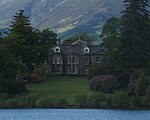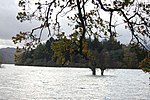Theatre by the Lake

Theatre by the Lake is situated on the shores of Derwentwater in the Lake District in Keswick, Cumbria, England. It opened in 1999, replacing the mobile Century Theatre, and was made possible by an Arts Council Lottery Fund Grant. From May to November a resident company of up to 14 actors perform a Summer Season of six plays in repertory. The theatre also produces a Christmas show and two Spring shows (one in the Main House and one in the Studio). The theatre hosts festivals including the Words by the Water literature festival, the Jennings Keswick Jazz Festival, Keswick Film Festival and events in the Keswick Mountain Festival. In addition, the theatre offers a wide range of visiting drama, music, dance, talks, comedy and film.
Excerpt from the Wikipedia article Theatre by the Lake (License: CC BY-SA 3.0, Authors, Images).Theatre by the Lake
Lake Road,
Geographical coordinates (GPS) Address Phone number Website External links Nearby Places Show on map
Geographical coordinates (GPS)
| Latitude | Longitude |
|---|---|
| N 54.5955 ° | E -3.1394 ° |
Address
Theatre by the Lake
Lake Road
CA12 5DJ
England, United Kingdom
Open on Google Maps










